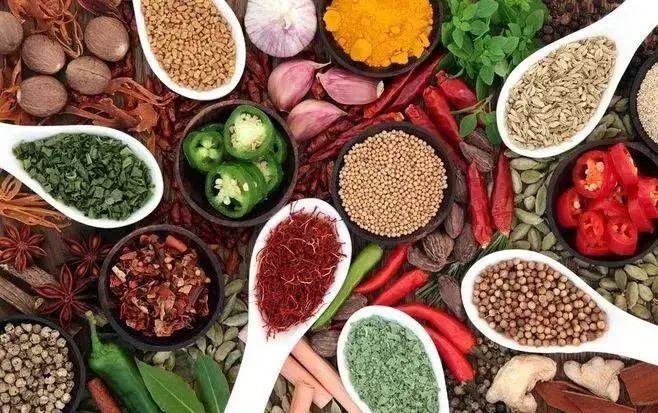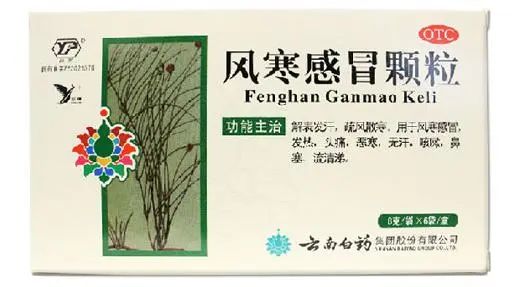Last time, I mentioned discussing the traditional Chinese medicines for treating wind-cold common cold, and today we will begin.
Why discuss wind-cold common cold? Because this year’s six qi (气) is characterized by an excess of wind and wood, along with the influence of the cold water qi, creating an environment where wind and cold overlap. One is wind, and the other is cold, combined they form wind-cold.
So today, we will talk about the medicinal treatments for wind-cold common cold.

Wind-cold common cold (Image source: Internet)
(1)
First, what is wind-cold common cold?
Simply put, wind-cold common cold is a cold caused by the combination of wind and cold pathogens.
Of course, wind pathogens can combine with any of the other six external pathogens to form wind-heat, wind-damp, or wind-dry colds. However, the most commonly discussed are wind-cold and wind-heat.
Note: Colds are not limited to just wind-cold and wind-heat; other forms such as wind-dry, wind-damp, wind-cold-damp, wind-damp-heat, and wind-cold with heat are also possible.
This is the pathogenic combination of the six external pathogens. How do these combinations occur?
Answer: Any combination is possible at different times and places. The five movements and six qi in TCM can predict the most likely combinations to some extent.
This is the integration of the six external pathogens with the five movements and six qi.
Thus, our understanding of external diseases is somewhat chaotic. The correct approach is not to invent more concepts but to effectively utilize the existing ones. Properly using the original concepts is sufficient to address all external diseases.
Once we clarify the nature of the pathogenic factors, we can determine how to treat them.
How to treat wind-cold common cold? Expel wind. How to treat cold common cold? Disperse cold. How to treat wind-cold common cold? Expel wind and disperse cold.
What kind of Chinese medicine can expel wind? Spicy-flavored herbs. Not warming herbs, not cooling herbs, but spicy-flavored herbs. Both warm and cold spicy herbs can expel wind. This is the concept of spicy-warm and spicy-cool in TCM.
From this point, we can see that the medicinal properties most closely related to the efficacy of Chinese herbs are not the four qi but the five flavors.
Now, what herbs can disperse cold? Warming herbs, as the cold is treated with heat.
However, from the perspective of flavor, it is still spicy and salty herbs that can disperse cold. Why? Because spicy nourishes the liver, and salty nourishes the heart. The liver wood and heart fire represent spring and summer, the seasons of rising yang energy. Therefore, spicy and salty flavors inherently possess warming properties that promote yang.
Conversely, sour nourishes the lungs, and bitter nourishes the kidneys. The lung metal and kidney water represent autumn and winter, the seasons of gathering yang energy. Thus, sour and bitter flavors inherently possess cooling properties that nourish yin.
Hence, the Huangdi Neijing states that spicy and sweet disperse yang, while sour and bitter drain yin.
Therefore, we conclude that to simultaneously expel wind and disperse cold, spicy herbs are the best choice.

Spicy herbs (Image source: Internet)
(2)
Is this the real situation? Yes.
Let’s look at standard spicy herbs, such as Gui Zhi (Cinnamon Twig), which is a warming herb. A standard salty herb, Xuanfu Hua (Inula Flower), is also a warming herb.
Thus, we say that the standard treatment for wind-cold common cold should primarily use spicy herbs.
In the “Tang Ye Jing Fa Tu” system, spicy-warm herbs are purely spicy herbs, while spicy-cool herbs are those that combine spicy and bitter properties, where the spicy flavor expels pathogens and the bitter flavor clears heat. Herbs like Jin Yin Hua (Honeysuckle), Lian Qiao (Forsythia), and Bo He (Mint) are all spicy-cool herbs.
Next, following this line of thought, let’s look at representative formulas and traditional Chinese medicines for treating wind-cold common cold.
The first and most typical is Ma Huang Fu Zi Xi Xin Tang (Ephedra, Aconite, and Asarum Decoction).
In this formula, Ma Huang (Ephedra) is spicy, Fu Zi (Aconite) is spicy, and Xi Xin (Asarum) is spicy, all three are spicy, which expels pathogens and disperses cold. This is a classic formula for treating wind-cold common cold, used for patients with mental fatigue, general malaise, extreme chills, and cold extremities.
Of course, Fu Zi is not purely a spicy herb; it also has a bitter flavor, but this bitterness is not the draining type but rather a nourishing type for the kidneys. Therefore, the efficacy of Ma Huang Fu Zi Xi Xin Tang is more focused on dispersing cold rather than expelling pathogens. Teacher Huang Huang once said that one characteristic of the Ma Huang Fu Zi Xi Xin Tang syndrome is the patient’s extreme cold sensation.
Thus, this formula is indeed classic, but due to its strong potency, it is not commonly used.
The second typical formula is Jing Fang Granules.
The composition of Jing Fang Granules includes Jing Jie (Schizonepeta), Fang Feng (Siler), Qiang Huo (Notopterygium), Du Huo (Angelica), Chai Hu (Bupleurum), Qian Hu (Peucedanum), Chuan Xiong (Ligusticum), Zhi Ke (Bitter Orange), Fu Ling (Poria), Jie Geng (Platycodon), and Gan Cao (Licorice). In this formula, all herbs except Gan Cao contain spicy flavors.
Of course, many herbs are not purely spicy herbs; they just contain spicy flavors. For example, Qiang Huo, Du Huo, and Jie Geng also have bitter flavors, but this bitterness is not the draining type nor the nourishing type, but rather a drying type for the spleen. Similarly, Chai Hu and Zhi Ke have sour flavors.
However, overall, this is still a traditional Chinese medicine for treating wind-cold common cold.
The instructions also state: “Induces sweating and expels pathogens. Used for wind-cold common cold, headache, body aches, chills without sweating, nasal congestion with clear discharge, and cough with white phlegm.”
The third typical formula is Ma Huang Tang (Ephedra Decoction) and San Ao Pian (Three Astringent Tablets).
The composition of Ma Huang Tang includes Ma Huang (Ephedra), Gui Zhi (Cinnamon Twig), Ku Xing Ren (Bitter Apricot Kernel), and Gan Cao (Licorice). The composition of San Ao Pian includes Ma Huang (Ephedra), Ku Xing Ren (Bitter Apricot Kernel), Gan Cao (Licorice), and Sheng Jiang (Fresh Ginger). These two formulas are quite similar, both structured as “two spicy and one bitter and one sweet.” However, Ma Huang Tang contains Gui Zhi, while San Ao Pian contains Sheng Jiang, making them similar in terms of expelling pathogens and dispersing cold.
Both formulas have a sub-structure of “two spicy and one sweet,” so they can be used to expel wind, disperse cold, and expel pathogens, which is the basic treatment for wind-cold common cold.
At the same time, they include Ku Xing Ren, which is primarily a bitter flavor. The presence of both bitter and sweet flavors, which can be used for cough, allows for a combination of bitter and sweet to expel phlegm and stop cough.
Thus, Ma Huang Tang and San Ao Pian are representative formulas for treating wind-cold common cold, characterized by fear of cold, nasal discharge with clear fluid, and cough.
In other words, the introduction of bitter herbs has changed the efficacy positioning of these two formulas, making the lung-clearing and cough-stopping effects more pronounced.
The fourth typical formula is Gan Mao Shu Feng Granules (Common Cold Wind-Expelling Granules).
Gan Mao Shu Feng Granules consist of Ma Huang (Ephedra), Ku Xing Ren (Bitter Apricot Kernel), Gui Zhi (Cinnamon Twig), Bai Shao (White Peony), Zi Su Ye (Perilla Leaf), Fang Feng (Siler), Jie Geng (Platycodon), Gu Ya (Barley Sprout), Gan Cao (Licorice), Da Zao (Jujube), Sheng Jiang (Fresh Ginger), and Du Huo (Angelica). This formula combines the Ma Huang Tang and Gui Zhi Tang formulas, with some modifications.
While Ma Huang Tang is characterized by its bitter herbs, Gui Zhi Tang lacks bitter herbs. Therefore, Gui Zhi Tang remains focused on treating liver wood.
When these two formulas are combined, along with spicy herbs like Zi Su Ye, Fang Feng, and Du Huo, and bitter herbs like Jie Geng, along with sweet herbs like Da Zao and Gu Ya, it forms a formula that can both nourish the liver and disperse cold, as well as clear the lungs and stop cough.
In other words, Gan Mao Shu Feng Granules are an upgraded version of San Ao Pian. The principles of their formulation are entirely similar, just with different herbs used.
The instructions for Gan Mao Shu Feng Granules state: “Spicy-warm, expels pathogens, and harmonizes the lungs. Used for wind-cold common cold, fever, cough, headache, fear of cold, nasal discharge, and body aches.”
All four classic wind-cold common cold treatments share a common characteristic: their formulations are primarily based on warming herbs, even if they contain bitter herbs, they are primarily for nourishing the kidneys or drying the spleen, rather than typical bitter herbs that drain heat.
The fifth typical formula is Wind-Cold Common Cold Granules.
Wind-Cold Common Cold Granules are very similar to Gan Mao Shu Feng Granules, as their formulation is a modification of the Ma Huang Tang formula, except this formula contains Ge Gen (Kudzu Root) and lacks Bai Shao.
The specific instructions state: “Expels pathogens and induces sweating, disperses wind and cold. Used for wind-cold common cold, fever, headache, chills, no sweating, cough, nasal congestion, and clear discharge.”
These two medicines are so similar that in clinical prescription reviews, the combined use of Wind-Cold Common Cold Granules and Gan Mao Shu Feng Granules is considered a textbook example of repetitive use of traditional Chinese medicines.
Remember this repetitive use combination, and you will remember these two medicines.
Next, let’s look at the atypical ones.

Wind-Cold Common Cold Granules (Image source: Internet)
(3)
Atypical formulas include those that contain bitter herbs that drain heat and clear heat in the treatment of wind-cold common cold. However, since the entire formula primarily focuses on expelling wind and dispersing cold, the presence of a small amount of bitter heat-clearing herbs does not affect the treatment direction.
The sixth is Tong Xuan Li Fei Wan (Unblock and Regulate Lung Pill).
Tong Xuan Li Fei Wan consists of Zi Su Ye (Perilla Leaf), Qian Hu (Peucedanum), Jie Geng (Platycodon), Ku Xing Ren (Bitter Apricot Kernel), Ma Huang (Ephedra), Gan Cao (Licorice), Chen Pi (Tangerine Peel), Zhi Ban Xia (Processed Pinellia), Fu Ling (Poria), Chao Zhi Ke (Stir-fried Bitter Orange), and Huang Qin (Scutellaria). Here, Huang Qin is a typical heat-clearing herb. Additionally, the atypical heat-clearing herb Qian Hu also contributes to a certain degree of heat-clearing effect.
Whether through guiding or assisting, it is indeed present.
At the same time, Tong Xuan Li Fei Wan enhances the effects of stopping cough and expelling phlegm. Why? Because in addition to the previously mentioned Ku Xing Ren and Jie Geng, this formula also includes Ban Xia, Chen Pi, and Fu Ling. Ban Xia and Chen Pi are spicy herbs, but they are not for expelling pathogens; rather, they are for drying the spleen and expelling phlegm. Fu Ling is a sweet herb that also helps to expel dampness.
Thus, the efficacy positioning of this formula, besides addressing liver wood and lung metal, also clearly considers the spleen earth.
Recently, we discussed the use of cold and heat in common cold traditional Chinese medicines, and this formula was even classified as a treatment for cold and heat combined.
Of course, it still primarily focuses on expelling wind and dispersing cold. The instructions state: “Expels pathogens and disperses cold, clears the lungs and stops cough. Used for wind-cold binding the exterior, and lung qi not dispersing, resulting in common cold cough, symptoms include fever, chills, cough, nasal congestion with runny nose, headache, no sweating, and body aches.”
Similar to Tong Xuan Li Fei Wan, there are several others.
The seventh is Jiu Wei Qiang Huo Wan (Nine Flavor Notopterygium Pill).
Jiu Wei Qiang Huo Wan is often used as a treatment for wind-cold common cold. However, from the perspective of its formulation, it is an atypical wind-cold common cold treatment.
The reason lies in the inclusion of Cang Zhu (Atractylodes), Huang Qin (Scutellaria), and Di Huang (Rehmannia) in the formula.
Cang Zhu is a bitter herb, primarily used for drying the spleen and expelling dampness. Huang Qin is a bitter herb, primarily used for draining heat. Di Huang is also a bitter herb, primarily used for nourishing the kidneys and clearing heat.
These three herbs give Jiu Wei Qiang Huo Wan not only the ability to expel wind and disperse cold but also a clear damp-drying effect and certain nourishing and heat-clearing properties. Therefore, the instructions for Jiu Wei Qiang Huo Wan state: “Expels wind, releases the exterior, disperses cold, and eliminates dampness. Used for common cold caused by external wind-cold with dampness, symptoms include chills, fever, no sweating, headache, and body aches.”
The eighth is Zheng Chai Hu Yin Granules (Correct Bupleurum Decoction Granules).
Zheng Chai Hu Yin Granules is also an atypical wind-cold common cold traditional Chinese medicine, which is evident from its formulation.
Zheng Chai Hu Yin Granules consists of Chai Hu (Bupleurum), Chen Pi (Tangerine Peel), Fang Feng (Siler), Gan Cao (Licorice), Chi Shao (Red Peony), and Sheng Jiang (Fresh Ginger). Here, there are neither familiar Ma Huang nor Gui Zhi, nor typical spicy-warm herbs like Jing Jie, Bai Zhi, Qiang Huo, and Du Huo. In this six-herb formulation, Sheng Jiang, Chen Pi, and Fang Feng are warming, while Chai Hu and Chi Shao are cooling, and Gan Cao is neutral, making it a typical cold-heat combined traditional Chinese medicine.
The instructions for its efficacy state: “Expels wind-cold, relieves heat, and stops pain. Used for the initial stage of external wind-cold: fever, chills, no sweating, headache, nasal congestion, sneezing, itchy throat, cough, and body aches. Also applicable for the initial stage of influenza and mild upper respiratory infections with the above symptoms.”
As you can see, it has a strong sense of cold-heat combination and conflict.
(4)
Alright, we have discussed several typical, relatively typical, and atypical wind-cold common cold traditional Chinese medicines.
So, does this mean that typical medicines are good and atypical medicines are bad?
Not necessarily.
We have mentioned that every traditional Chinese medicine is a key with edges, each with its own indications and the specific lock it can open. The key is to choose the right key for each lock.
Typical wind-cold common cold traditional Chinese medicines should be used for typical wind-cold common cold. Atypical wind-cold common cold traditional Chinese medicines should be used for atypical wind-cold common cold.
For those with wind-cold common cold exterior symptoms that easily progress to cough, traditional Chinese medicines containing bitter apricot kernel are very good.
For those in northern heated areas, who usually wear too much, have a hot constitution, or love spicy hot pot, traditional Chinese medicines containing heat-clearing bitter herbs are also very good.
Or, from the perspective of this year’s Shao Yang fire governing the heavens, and the terminal qi of the guest qi with wind and wood, which also carries a rising yang attribute, this wind-cold may also express itself in a mixed cold-heat form.
Thus, although they are all traditional Chinese medicines for treating wind-cold common cold, each medicine has its own characteristics and edges. Sometimes we focus on their commonalities; sometimes we focus on their individualities.
Finally, after discussing so much, I hope everyone has a clear understanding of traditional Chinese medicines for wind-cold common cold. With a clear understanding, one can make informed choices in medication.

